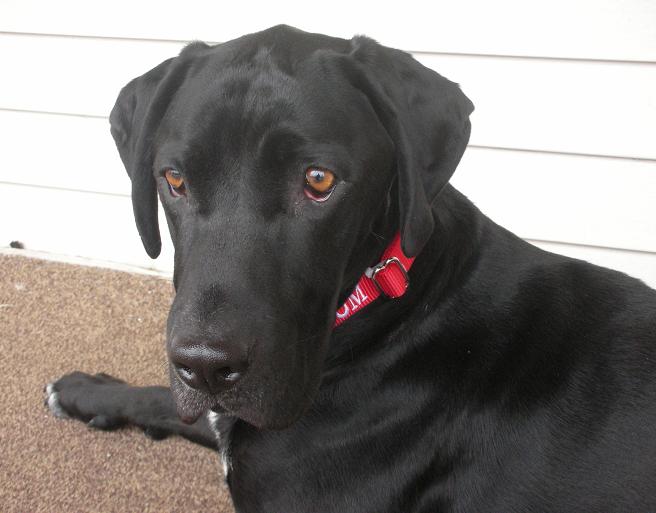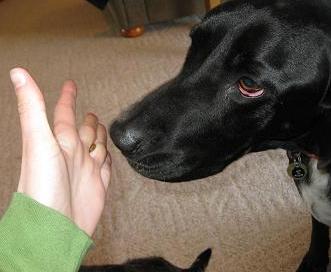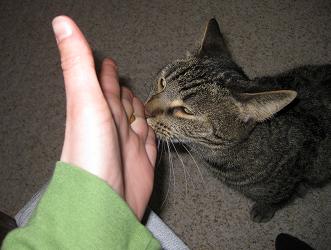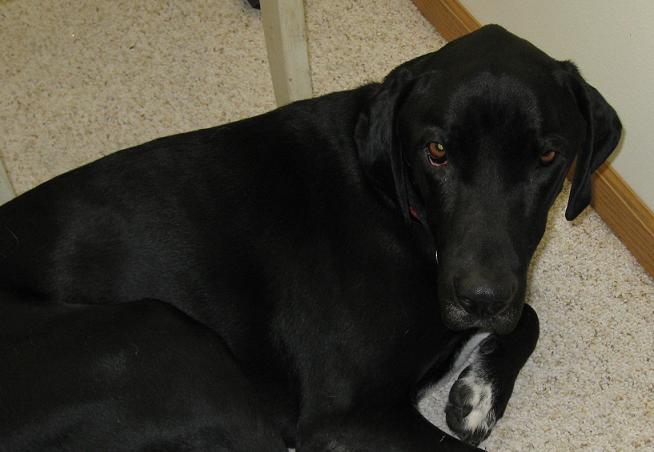I am teaching my mutt Ace the “touch” command.
I have a silent competition with my friend Maren to own the dog that knows the most tricks. Ace is now learning “touch” because Maren’s dog already knows it. She was nice enough, though, to help Ace and I.
The touch command seems pointless at first, a modified version of “come.” The goal is to have my dog touch his nose to the palm of my hand whenever I say “touch.”
Ace seems to understand the command already and comes running, eager for a treat. He’s up for anything that involves food and has always had an almost perfect recall (click here for how to teach your dog to come).

Uses of the touch command
1. The touch command can substitute for the come command.
Since most dogs will enjoy the touch command, it can be used as a substitute for the word “come.” If your dog knows touching your hand will result in a treat or praise, then he will always be eager to run up and touch your hand. “Touch” should be fun for your dog, like a game.
2. You can teach your dog to touch any object.
The touch command is used to start more advanced “targeting.” Targeting is when a dog is taught to push, press or touch an object. Once my dog will touch my hand, I will be able to direct him to “go touch” objects further away. This is how trainers begin to teach service dogs to hit a light switch or to lock doors. The possibilities are endless.
Ace probably won’t be doing anything useful. Instead he’ll be learning this command to challenge him mentally. Plus, it’s cute. In a way, he has some targeting already learned. When I tell him to “get Scout,” he runs over and licks my cat. Scout is such a good sport!
3. Use the touch command to redirect your dog’s attention.
You can use the touch command to distract your dog from something he might bark at on a walk or while you are at home. I already used the touch command last night to distract Ace from another dog that was in our yard. He was starting to growl at the distant dog, but when I told him “touch,” he focused on me instead.
How to teach your dog the touch command:
When training a dog to do anything, it’s best to break a concept down into simple steps. I don’t use a clicker, but the touch command would be the perfect time to introduce your dog to clicker training. With clicker training, you immediately click when your dog does the behavior you are looking for.


1. Hold out your hand and tell your dog to touch.
Put a small treat between two of your fingers to attract your dog’s nose to your hand (this also works for cats).
It’s easiest if your dog is sitting or standing in front of you at first. Just hold out that hand and say “touch.” Your dog will automatically put his nose to your hand looking for that treat!
2. Reward the dog by giving him a different treat with your other hand.
If you are using a clicker, hold it in your opposite hand and click as soon as your dog’s nose touches your hand. Then give him a treat.
Do not let your dog take the treat from the hand he touched. Instead, immediately give him a treat from your other hand. This will teach him to quickly touch your hand and then look to you for a treat. The goal is to touch your hand, not look for the treat.
You will soon be able to direct your dog to touch objects that are further away. He will touch an object and then get a reward from you.
If you want your dog to go look for treats, then teach your dog to “find it,” which is different than “touch.”
3. Change the height of your hand.
Once your dog has been successful touching your hand in one spot, move your hand a little higher or lower and say “touch.”
4. Say “touch” without a treat in your hand.
It will probably only take your dog two or three repetitions to figure out if he touches his nose to your hand he gets a treat. So, after success with that step, move on and hold out your hand with nothing in it. Say “touch” and give him a treat from your opposite hand once he does it. If your dog is confused, then go back to using treats.
5. Switch hands.
Hold out your opposite hand and say “touch.” Give the reward from the other hand.
After I had been using the same hand for quite awhile, I saw Ace thinking about what to do when I switched hands. I caught that mutt off guard! Ace was confused at first, so I put one hand behind my back.
This gave him one option, touch the outstretched hand! I rotated hands every other time for awhile, so he learned to look for the hand I held out.
Touching your hand might be enough for you and your dog, but to make it more interesting, you can teach him to touch other objects by holding them or pointing to them. From there, you can direct him to touch objects further away by pointing to things and saying, “Go touch.”
6. Teach your dog to “touch” an object.
With this step, you will do the same as step one, but instead of holding out your open hand you will hold out a book or other object. You can use a Post-it note to help your dog understand exactly where to touch. That way you can move the Post-it note to other objects later on. Say “touch” as usual, and when your dog touches the book or Post-it, give him a treat.
7. Move the object.
This is the same concept. Once your dog is comfortable touching an object you are holding, place the same object on the ground and say “go touch” or whatever command you want to use.
When he does, give him a treat. If he doesn’t understand, then go back to the previous step. You may have to tap on the object or even set a treat on it to get your dog to touch it the first time. Just remember not to let him take the treat from the object. The reward should come from you.
You could place the object in any easy to reach spot like a low table or a chair.
8. Slowly increase the distance.
Once your dog understands the concept of “go touch,” you can keep moving the object further and further away.
9. Repeat the steps with several different objects.
Don’t introduce new objects until your dog is successful with the first object. The more you add, the more likely he will get confused.
10. Introduce more complex tasks.
For teaching tasks like hitting a light switch or locking a door, you would use the same concept by continuing to add simple steps. If you want your dog to touch a light switch you would have to first hold your hand or another object in front of the switch and say “touch.”
Or, put a Post-it note right on the switch. Eventually, you will be able to move your hand at the last second or remove the Post-it so your dog hits the switch without even trying.
After several repetitions you could point to the switch and say “touch.” Eventually, move further away and say “go touch” or whatever command you want to use like “get the lights.”
Next, work on building distance again. Just remember to work very slowly. This whole process could take several weeks for your dog to learn. If you rush your dog, he will only get confused and you will get frustrated.
Really, the options are limitless. But maybe there are some things you don’t want to be teaching your dog like ringing bells, opening cupboards or unlocking doors!
Does your dog know “touch”? What are some other uses for the touch command?
How do you teach the touch command?
Let me know in the comments!


Di
Friday 16th of January 2015
I recently rescued a younger dog (almost 2) with some unsavory dog-to-dog aggression issues. I am training her from scratch with the help of a behaviorist. Her high prey drive is one piece of the puzzle and managing it will be part of the solution as well as gaining her complete trust and focus on me when I ask for it.
I've been trying to find ways to play ball with her that didn't involve chasing it and amping her up. For fun today, I tried teaching her PUSH. I've never tried anything like it but I know this dog has incredible intelligence that I need to tap into. We sat facing each other and I rolled the ball to her while saying PUSH. Then I rolled it back from her to me and said PUSH. It only took two, 10-minute sessions for her to understand and play it well! She had a big time pushing it back to me with her nose. After an hour on the treadmill and two games of PUSH, she is out cold!
I'll be following your blog and I thank you for posting it! I have a FB page dedicated to the rehabilitation of my girl called Petunia's Rehabilitation. Come on over and learn with us!
Lindsay Stordahl
Sunday 18th of January 2015
Thanks so much for your comment. That sounds like a great game for her! I will check out your Facebook page.
Lindsay Stordahl
Thursday 22nd of November 2012
Sounds like a great idea for your dog!
Steph Pierotti
Wednesday 21st of November 2012
I taught my rescue pup the "touch" command several months ago, and much in the same way as you've described here. I decided to teach Ripley this trick when I first began exploring how to go about getting him trained as a therapy dog. I work as an early intervention therapist doing Applied Behavior Analysis (ABA) therapy with children diagnosed with autism spectrum disorders, and though I would love to have Rip trained to work with these children, I think the process would require more time than I currently have as a full-time college student who also works 5 days a week, haha. However, I was very interested in getting the training necessary for Rip to be able to visit people in the hospital--and that's when I came across the "touch" trick. My favorite use for this command is to show children, or anyone else who might be hesitant around dogs, that there is nothing to fear! Suppose you were in a hospital setting and the child was scared to approach or pet your pup... you can simply get them to hold out their hand, or an object if they prefer, then give/let them issue the command to the dog. Ripley is an EXTREMELY hyper and active dog (whippet/lab mix), so I always tried to keep the environment relatively calm when practicing this trick so that his easy demeanor would transfer over in a variety of settings whenever he was exposed to the command. After all, I wouldn't ever want to terrorize a child by having my 50 lbs dog bound over to them excitedly trying to play ;)
Art Hess
Friday 2nd of March 2012
This is also a useful tool for those who want to teach their dog to ring a bell hanging from the door knob when they want to go out.
Jwilliams
Sunday 19th of February 2012
Thanks for the information. I've been teaching. Clicker training sit, here, spin, and recently touch with my 8 week old border collie. I have seen lots of videos on the touch command but this is the first site I've seen that explained WHY to use it.
Lindsay Stordahl
Saturday 25th of February 2012
Glad I could help!